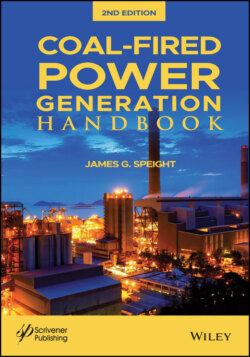Читать книгу Coal-Fired Power Generation Handbook - James Speight G., James G. Speight - Страница 37
2.3.4 Coal Survey
ОглавлениеThe use of coal as an essential fuel in Britain from the time of the Industrial Revolution has led to the development of a system of classification in which code numbers are used to denote the different types of coal. The coal survey system (developed by the National Coal Board of the United Kingdom) is based on the coke-forming characteristics of the various coals as well as on the types of coke produced by a standard of coking test (the Gray-King carbonization assay). The system also employs the amount of volatile matter produced thermally by the various types of coal (Table 2.7). In this classification system, a three-figure code number is used to describe each particular coal (Table 2.7) – the lower numbers are assigned to the higher rank coal, i.e., anthracite. However, because of the various divisions of this particular system, such approximations have to be made with extreme caution and with extremely careful cross-checking.
Although the English system does appear to have some merit because of the dependence on two simple physical parameters (i.e., the volatile matter content of the coal and the Gray-King carbonization assay), there are, nevertheless, disadvantages to the method, not the least of which is the susceptibility of the Gray-King assay data to oxidation (weathering) of the coal and, apparently, the time required to conduct the assay.
Table 2.6 Differentiation of coal rank, coal type, and coal grade.
| Rank |
| Indicative of the degree of metamorphism (or coalification) to which the original mass of plant debris (peat) has been subjected during its burial history. |
| Dependent on the maximum temperature to which the proto-coal has been exposed and the time it has been held at that temperature. |
| Also reflects the depth of burial and the geothermal gradient prevailing at the time of coalification in the basin concerned. |
| Type |
| Indicative of the nature of the plant debris (proto-coal) from which the coal was derived, including the mixture of plant components (wood, leaves, algae) involved and the degree of degradation before burial. |
| The individual plant components occurring in coal, and in some cases fragments or other materials derived from them, are referred to as macerals. |
| The kind and distribution of the various macerals are the starting point for most coal petrology studies. |
| Grade |
| Indicative of the extent to which the accumulation of plant debris has been kept free of contamination by inorganic material (mineral matter), before burial (i.e., during peat accumulation), after burial, and during coalification. |
| A high-grade coal is coal, regardless of its rank or type, with a low overall content of mineral matter. |
